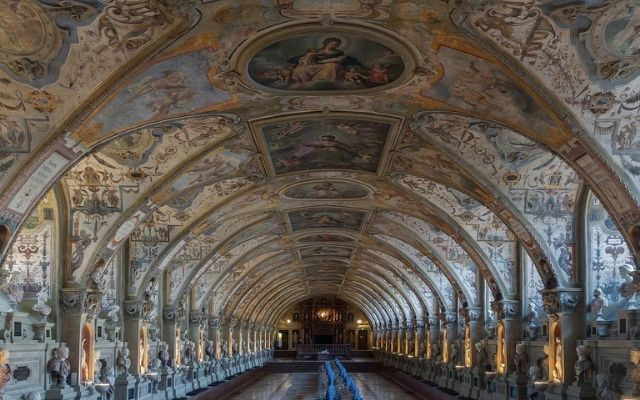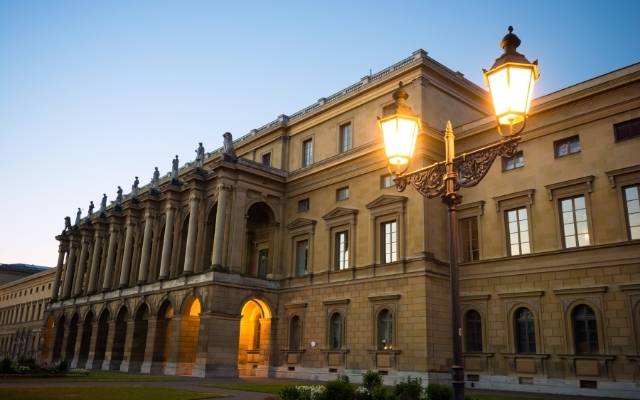The largest inner-city palace in Germany, complete with sprawling gardens and unmissable artworks, the Munich Residenz is the one-stop many travelers to Munich should make an effort to visit.
In the unparalleled luxury of the Munich Residenz’s countless courtrooms and halls, it’s easy to feel like royalty, and with ten courtyards and 130+ rooms, there’s some amazing spots within to inspire an Instagram photo or two.
But the Munich Residenz Museum Complex has a lot more to offer visitors than just a vast palace with some pretty rooms.
The building is constructed on a foundation of the city’s history, serving as an important part of the Bavarian government for hundreds of years, and a visit to Munich is simply not complete without seeing this gorgeous palace.
We hope you enjoy the read on the Munich Residenz and that you’ll be inspired to visit this wonderful place.
What is the Munich Residenz?
The former seat of Bavarian royalty, the Munich Residenz is also known as the Wittelsbacher Residenz, after the royal family it housed.
Situated in the northeast corner of Munich city center, the oldest part of the Munich Residenz was built in 1385 and was, in fact, a Medieval fortress, and it wasn’t until the 1500’s that it became a residential palace.
Parts of this original Medieval Castle, known as the Nueveste (the New Fortress), were demolished over the following 400 years as the Munich Residenz evolved to suit each passing generation.
King Ludwig I’s grand plans for the Residenz eventuated between 1825 and 1835 and the building and complex morphed into what we currently see on this expansive historical Munich site.
Who Built the Munich Residenz?
It was Duke Stephan III (“the Fop”) who first began the Residenz construction with Munich’s moated New Fortress.
Each subsequent ruler that sat on the Bavarian throne had their influence, and the complex sprawled from defensive keep to palatial grandeur over the following centuries.
It was Maximilian I who made the most sweeping alterations to the Residenz by commissioning a number of grand embellishments to the palace including a court chapel, an Imperial Staircase, an Imperial Hallway, and the beautiful court garden.
The redesign of the outdoor courtyard to connect all the separated parts of the complex and became the Fountain Court remains Maximilians most memorable addition to the palace. The courtyard houses one of the most beautiful sculptural fountains in Munich but as its internal, you won’t see this simply walking by so do make an effort to find it.
King Ludwig I, with his favoured court architect, Leo Von Kleze, made massive extensions between 1825 and 1848, and one can certainly see that Ludwig’s love of Italy and the Renaissance was the inspiration behind the style of the extension plans. Of particular interest was the addition of the Court Church of All Saints which was based on the Norman-Byzantine Palatine Chapel in Pallermo, Sicily.
Finally, it was the last King of Bavaria – King Ludwig III – who installed electricity, elevators, central heating, and plumbing that brought the building into the modern era.
Almost completely destroyed in allied bombing raids on Munich in the latter part of World War II, the total reconstruction of the Munich Residenz, to become the building we see today, took several decades.
Who Lived in the Munich Residenz?
In short, the Wittelsbachs family who were the absolute rulers of Munich, Bavaria, and even far further afield, were the mainstay of residents in the Residenz.
All Bavarian Dukes, Electors, and Kings, all from the line of Wittelbasch, resided here in the Munich Residenz at some point between 1508 and 1918.
This was Bavaria’s seat of power, and where the state was governed by Duke Albert IV of Bavaria right through until the reign of the last king of Bavaria – King Ludwig III.
During their time in power, the Wittelbaschs were active “empire builders”. as they strove to dominate this part of Europe through their aggressive constructions of palaces and other “monumental” architectural projects.

What Can You See at the Munich Residenz?
The Munich Residenz is actually a sort of conjoined complex of buildings that is made up of three main parts.
- The Königsbau (the Royal Building) houses the Royal State Apartments and the Royal Treasury and includes many other suites and reception halls.
- The Alte Residenz (Old Residence) houses the Antiquarium, one of the oldest Renaissance vaults in Europe, the Witwenstock (Widow Wing), the Residenz Theater, and the wonderful Court Garden.
- The Festsaalbau, houses more than one throne room, various dining reception rooms, concert halls such as the Herkulessaal – Hercules Hall, and the Winter Garden.
With just too many wonderful rooms, corridors, hallways, and gardens of the Munich Residenz to list in their entirety, here we’ve chosen our best parts of the complex to view in no particular order.
Bronze Halls – Bronzesäle
The Bronze Halls are the picture of opulence, featuring stunning painted ceilings, and ornate walls lined with 40 bronze sculptures commissioned for the Residenz in the 16th and 17th centuries.
This is perhaps the most valuable collection of original European bronze art from the Mannerism and early Baroque eras created primarily by sculptures Hubert Gerhard and Carlo di Cesare del Palagio.
Guided tours and Audio Tours are available to learn more about the Munich Residenz and its magnificent artwork collections, and for anyone with an artistic eye and an interest in statues, then the sculptures and statues of the Bronze Halls should certainly be a part of any tour of the building.
Munich Residenz Treasury – die Schatzkammer
You’ve heard of the “Crown Jewels” housed in London’s Tower surely, well this is the pretty much the German equivalent.
The Residenz’s Treasury houses numerous fine works of art including jewels and jewelry, goldsmith’s work, enamels, crystal objects, ivories, and more.
There are some revered religious implements and relics, an ancient book or two, and some wonderful Medieval artworks within the Treasury as well.
Like the rest of the palace, the bright gold decorations give this room an air of historic prestige. Among the paintings here you can also see the regal crowns and tiaras worn by the Bavarian royals and perhaps the most intriguing pieces are the ornate Ostrich Egg cups.
Royal Apartments of Ludwig I
Although it’s just a representation of King Ludwig I’s apartment and obviously with no kings living within today, this room is perhaps one of the best ways to see where the royals might have spent their day to day and to imagine what their opulent lifestyle might’ve been like.
Considered from very early on to be what was noted as being “in full view of the people”, the Royal Apartments were probably the very first part of the entire Residenz that was open to the public and could be visited during the monarch’s absence.
The rooms here, including the Queen’s Rooms, are hung with historical scenes depicted from the works of some famous German authors, and every detail of the apartments was designed to be uniform in late Neoclassical style.
Court Gardens – Hofgarten
The 400-year-old Hofgarten is a popular public green space in Munich lined with avenues of mulberry trees, numerous fountains, regimental strolling arcades, ancient fruit trees, and impressive statues.
The delightful atmosphere of the fresh gardens is a great way to escape the hustle and bustle of the city streets. The enchanting Dianatempel is a 12 sided gazebo offering some shade in front of dazzling fountains.
We have an entire article dedicated to the Hofgarten and we’d love it if you’d check out that article entitled Hofgarten Munich: 17th Century Italian Renaissance Garden
Cuvilliés Theatre
A leisure hotspot in Munich for centuries, the Cuvilliés Theatre (old Residenz theatre) is one of Munich’s most important artistic and cultural landmarks.
Designed by architect François Cuvilliés, the Cuvilliés Theatre, Munich’s “new opera house”, is a wonderfully ornate space of painted carved wood, marble figurine, and floral ornamentation all complemented with plush fabrics.
The theater is still open to this day for musicals, operas, and theatre shows in surroundings of rococo and baroque-inspired architecture.
The Antiquarium
If there’s just one part of the entire Munich Residenz Museum you should visit then the Antiquarium is definitely that part.
At 66 meters long this unbelievable space (room 7 of the Munich Residenz Museum), is the most extravagant display of a Renaissance hall north of the Alps.
Every part of this room is an exquisite piece of art within itself from the ornate windows to the busts and sculptures to the magnificence of the frescos and tiling.
Look for the 102 views of towns, palaces, and markets that are etched into the windows of the hallway, simply amazing.
Where is the Munich Residenz?
The entrance to the Munich Residenz can be found in Munich city center, on Max Joseph Platz but the actual address is Residenzstraße 1, 80333 München, Germany.
How to Get to the Munich Residenz?
While driving through Munich city center is possible, there is not much parking near the Munich Residenz. Instead, there are quite a few options in terms of public transport to make your day out at the Munich Residenz a breeze.
- TAXI: Opposite the Residenz, you’ll find the Max-Joseph-Platz taxi stand. Although this definitely won’t be the cheapest option, it’s incredibly convenient, dropping you right outside.
- TRAM: If you’re taking a tram to the Munich Residenz jump on the number 21 and alight at St. Veit Strasse.
- TRAIN: If you’re coming from outside the city center, the S-Bahn will likely be the most convenient transportation for you. The lines S1 and S8 both stop at Marienplatz, a leisurely 7 minute walk away past some of Munich’s other famous landmarks.
- UNDERGROUND: The U-Bahn lines U3, U4, U5, and U6 make a stop at Odeonsplatz.
- BUS: The number 100, and 153 buses will also bring you to Odeonsplatz.
- WALKING: Max-Joseph-Platz square is just a couple of minutes’ walk away from Odeonsplatz, and can easily be reached on foot if you are spending the day in the heart of the city as it is just a seven-minute walk from Marienplatz in the old town (Altstadt).
Munich Residenz Tickets?
Tickets for the Munich Residenz can only be purchased in person at the cash desk which also takes car payments.
The ticket price for the palace includes entry to the Residenz and Museum, and costs 9€ for anyone over the age of 18. A separate ticket is needed if you want to enter the Treasury, also at a price of 9€, however, if you’d like to do both on one day, a combined ticket of 14€ may be purchased.
Entry to the Theatre Cuvilliés is 5€ for an adult ticket and again, there is a full combination ticket including the Residenz Museum, the Treasury, and the Cuvilliés Theatre
Children and students with valid ID are admitted to all areas of the Residenz for free, and entry to the court gardens is free of charge for every visitor.
Munich Residenz Opening Hours?
The Munich Residenz Opening hours change seasonally and also differ in regard to which parts of the Museum are open and when. To be sure of getting the most out of your visit please remember to check with the official information listed on the Bayerische Schlösserverwaltung website and the dedicated Munich Residence websites pages HERE as good planning for your visit.
The below information is taken directly from the official website in June of 2022 where the opening hours of the Munich Residenz are as follows:
Open daily throughout the year except for January 1st, Shrove Tuesday, December 24th, 25th, and 31st.
Residenz Museum & Treasury
April-15 October | Daily 9am-6pm (last admission 5pm)
October 16-March | Daily 10am-5pm (last admission 4pm)
Cuvilliés Theater
April to July 31 | Mon-Sat: 2-6 p.m. Sun/Holidays: 9 a.m.-6 p.m. | last admission 5 p.m.
August 1st to September 12th | Mon-Sun: 9am-6pm | last admission 5pm
13 September to 15 October | Mon-Sat: 2-6 p.m. Sun/Holidays: 9 a.m.-6 p.m. | last admission 5 p.m.
16 Oct-31 Oct March | Mon-Sat: 2-5 p.m. Sun/Holidays: 10 a.m.-5 p.m. | last admission 4 p.m.
Munich Residenz Courtyard Garden Fountain (Wittelsbacher Fountain)
The fountain well is open to visitors daily from April to October daily between 10 a.m. and 2 p.m.
Munich Residenz Group Visitor Information
Group reservations are not actually required, but the maximum group size has a limit of 25 persons. At present, with some minor Covid Guidelines still in place, groups of more than 25 people must be divided and separate tour guides must be available to each specific group.
Munich Residenz Guided Tour Information
With no regular guided tours, available visitors are invited to make use of their own independent accredited tour guides that are permitted within the Residence Museum.
There are free audio guides available for the Museum and Treasury in a variety of languages – German/ English/ Italian/ French/ Spanish/ Russian/ Chinese/ Japanese
On request, and for an extra fee, private specialised group tours can be organised and from Spring to Autumn themed children’s tours are available.
Munich Residenz: Don’t Miss it
With over 90 different rooms open at any one time this wonderfully diverse Munich Museum can be difficult to see completely in a single day.
If palaces, antiquities, and the baroque/renaissance eras are your passion then we’d suggest a two day visit to the palace.
If you have a passing interest only, then perhaps stick to our recommendations above or devise your own itinerary depending on your particular preferences.
Whatever you decide, the Munich Residenz, although sometimes overlooked in many Munich Travel Itineraries, should be a must visit when you’re in the Bavarian Capital.
We hope you’ve enjoyed the article and equally, hope you’re inspired to visit the Munich Residence and perhaps discover some of the other Munich Palaces throughout the city.
Alternatively, nearby you can find the English Gardens – Englischer Garten, and a plethora of other Munich Museums such as the Egyptian Museum Munich and the Glyptothek Munich to name just a couple.
Cheers and thanks for reading.

